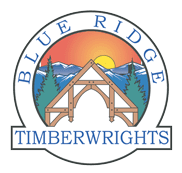Timber Frame FAQs
Q
What is a timber frame?
A
Timber framing is a specific type of Post and Beam construction that uses traditional wooden joinery to connect members. The most common connection is the use of a peg (trunnels or treenails) to secure a mortise and tenon joint. Timber frame structures exist today that have stood for 2,000 years or more, a testimony to their strength and durability. Timber framing in America and abroad has enjoyed a resurgence since the mid-1970s. Like their predecessors, today’s timber frames are strong and durable structures featuring the amenities of modern stick-built homes. Timber framing is used today for its unique styling, its exceptional strength, and its unique character. It is found in any place where the beauty of exposed beams and open spaces is desired. A major difference between timber framing and a conventional, or “stick-framed,” structure appears in the spacing of the frame members. A conventional framed structure uses 2-by-4-inch wall studs placed every 16 inches. By contrast, timber frame posts are 10 to 16 feet apart. Traditionally, timber frames were enclosed using an in-fill wall system that exposed the timbers to the inside of the home and the outside elements. This created a number of problems when dealing with modern-day conveniences and the desire for tight, energy-efficient enclosures. Having the timber exposed to the elements created the need to paint or tar the outside of the timbers to keep them from deteriorating over time. In-fill wall systems also reduced the appearance of the timbers in the home, as 8×8 posts became 2×8 posts when walls were built in between them. Today most timber frame structures use structural insulated panels (SIPs) or “stress skin” panels. SIPs are constructed of two pieces of oriented strand board with a rigid insulation material (EPS or expanded polystyrene) permanently bonded between them. SIPs have unmatched insulation value and add strength to the structure. Interior walls are partitional and a good place to hide electrical, plumbing, etc.
Timberwrights, those who craft and raise a timber frame, are a special combination of artisan, carpenter, and furniture maker. Each is a craftsperson who has developed the special woodworking skills necessary to size timbers, lay out and cut a wide variety of complex joinery details, and erect the frame at the building site. They master a number of woodworking skills and tools unique to the timber framing business. In addition, the timberwright must be very proficient with mathematics and plan reading.
Q
What is the difference between log construction, timber framing, and post and beam construction?
A
Log buildings have the logs, which are either round or squared off, stacked horizontally, creating the walls. Post-and-beam buildings are any buildings that have upright posts supporting horizontal beams. Timber framing is a specialized version of post-and-beam construction that is built like furniture, using mortise and tenon joinery, held in place with wooden pegs. Timber framing also allows you a choice of external finishes for your home, whether you prefer brick, siding, stucco, or other finishes. Log homes don’t give you these choices.
Q
What are the benefits of timber framing?
A
Aesthetics - The feel of a timber frame building is one of warmth, strength, and security. The knowledge that caring people handcraft your home adds a palpable quality. Additionally, you have a strong nailing surface wherever you want to hang something inside or out.
Energy Efficiency - Timber frame structures are often entirely enclosed in an envelope of structural insulated panels (SIPs), creating an extremely efficient and strong enclosure with high R values and low air infiltration. SIPs are constructed of two pieces of oriented strand board with a rigid insulation material permanently bonded between them.
Less Impact on the Environment - Consider using reclaimed timber, which is often salvaged from older structures such as large warehouses and port buildings. This material is environmentally friendly, saves the lives of today’s trees, and results in a timber frame filled with character and history.
Longevity - Timber frames are structurally very sound buildings that will last hundreds of years. Many have survived major natural disasters, including hurricanes and earthquakes, in excellent shape.
Stability - Unlike log homes, there are no settling problems to consider.
Open Floor Plan - Because there are typically no interior load-bearing walls, your floor plan can be very open and can be changed.
Q
How much do timber frames cost per square foot?
A
This question is similar to asking, “How much does a new car cost per pound?” The answer is, “It depends.” Many variables influence this cost. To produce an accurate estimate, you must first decide on a basic floor plan, rough frame design, and ideas about your choice of wood, finishes, and embellishment. Although some builders and timber framers offer a cost-per-square-foot range, many elements affect this range:
- How square footage is calculated greatly influences any estimate.
- Are porches, garage areas, basements, and air space above great rooms part of the calculations?
- Does the estimate include on-site raising by trained timberwrights?
Each combination of items skews the price from a quote. These are only a few of the considerations. To accurately compare estimates, ensure square footage is calculated similarly.
The price of a timber frame also varies according to how many pieces are used, how they are joined, what species and quality of wood is chosen, how the timbers are finished, what embellishments are added, and any exceptional site requirements.
Q
What affects a timber frame price besides square footage?
A
Frame Design - Some floor plans have several frame options. Adding or removing a bent can alter the number of total timbers by as much as 20 to 30 percent, greatly changing the cost per square foot.
Wood Quality - Moisture content and growth pattern greatly affect the strength and appearance of timbers. Choosing between green or seasoned wood, old growth or second growth, kiln-dried or reclaimed wood markedly affects the price of your frame. The more stable the wood (drier, denser), the less the joinery will open over time, and the less checking (cracking) you will see. In a well-built timber frame, shrinkage and checking are aesthetic rather than cost or structural issues.
Species - Timber frames employ a variety of species, each with its own advantages and disadvantages. Some are available in longer lengths, some offer greater strength in a smaller dimension, and some are considered more attractive or aesthetically interesting. Spruce, cedar, and pine offer a light finish, while oak, walnut, and more exotic woods are darker. Reclaimed materials offer a rustic feel, while newly cut timbers are appropriate for contemporary structures. Discuss the types, pros and cons, cost, and availability with your project coordinator.
Frame Detailing - Added embellishments on a frame, such as drop pendants, carvings, or other specialty work, will increase the price based on the intricacy and time involved.
Finish - Each choice – rough sawn wood, sanded, oiled finish, hand-hewn, adzed, sandblasted, nylon brushed, stained, colored washes – greatly determines the look and the cost of the project.
Site Requirements - Like any home construction, accessibility to your site can affect cost. Can a truck and trailer drive right to your site, or will there be extra handling? Can a crane be brought in?
The Rest of the House - You will make many decisions that will affect the finished square footage cost of your home. For example, stucco and slate roofs are more expensive than siding and asphalt shingles. Hybrids — part timber frame, part stick built — may reduce the overall project cost. Consider timber framing the public areas, such as great rooms and living areas, while using SIPs to build the wings.
Timber framing is only one part of the overall cost of your entire structure, whether commercial or residential. To help you understand the many aspects you may encounter, click here to download a Construction Cost Planning Worksheet for estimating and tracking your costs.
Q
What is the difference between reclaimed timber, seasoned and green timber?
A
Reclaimed timber is salvaged from older structures such as large warehouses and port buildings. Because of age, reclaimed timbers are dry and won’t shrink or check (crack) as much as green material. Reclaimed timbers can sometimes be found in large sizes and longer lengths because of the spans that were built in the older structures. After planning, the timbers retain signs of their previous life. The cost of reclaimed timber is generally higher than green timber due to the labor involved in acquiring it. Green (unseasoned) timber is the more commonly used in timber frame structures. Green timbers are available in many different species of woods and tend to be less expensive than reclaimed material. Checking and shrinkage occur in the timber as part of the natural drying process, although timber framers have methods and materials to keep shrinkage to a minimum. Shrinkage should not adversely affect the joinery or cause any structural weakness. Some information was provided by the Timber Frame Business Council, of which Blue Ridge Timberwrights is a Founding Sustaining Member.

